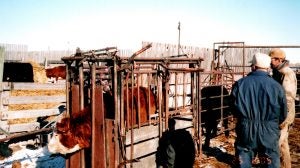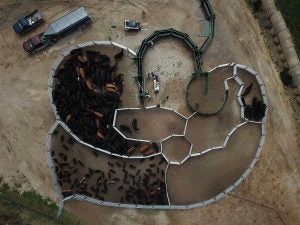The year is 2035. You wake up to the smell of fresh coffee and birds chirping on your smart home device. Your virtual assistant tells you that #236 is miles away from the rest of the herd, and that her vitals have been showing signs of high stress all night. You access your herd’s live feed to see how she is behaving, and you immediately notice her restlessness and discomfort. You hop into your truck, and the GPS leads you exactly where #236 is. Five minutes later, your vet shows up …
The world is evolving at a rapid pace. With the rise of self-driving tractors, motion-activated cameras, and livestock monitoring smartphone apps, it is clear the agricultural industry is adapting to the future one innovation at a time. Here are a few examples of innovations in the beef cattle industry today:
- Smartphone apps for monitoring BCS and overall herd health
- Drones for herding, managing pastures, and checking fences & resources
- RFID cattle ear tags for identification and recording individual data
- Sophisticated livestock genetic research for more efficient cattle breeding
- Cattle equipment designed for humane livestock handling
Today’s beef situation
All sectors of the cattle industry are faced with challenges brought by false information propagated in mass media. Since livestock businesses have been placed under a microscope, one wrong move can end up in tomorrow’s viral headline. Today, all eyes are on the modern cowboys and how they manage their livestock.
How can cattle ranches use today’s innovations to protect the integrity of the cattle industry?
The answer is a collective action among ranchers and manufacturers alike to improve cattle operations, and adhere to welfare standards in the present day. Of the five cattle industry innovations listed above, the one aspect cattle-ranch operations struggle to upgrade is their livestock handling equipment.

As the saying goes, “If it ain’t broke, don’t fix it.”
… But functioning cattle equipment does not always mean that it is not broken or outdated. There is no question that a well-maintained cattle squeeze chute from the ’90s can still catch and contain an animal as it was designed to. However, does it adhere to the quality and safety standards of today? Probably not.
Over the past 30 years, the cattle industry experienced a shift when animal science researchers focused on the negative effects of stress on cattle — mostly due to traditional ways of cattle handling. Cattle that experience high-stress situations result in lower immune systems, slower weight gain, and lower conception rates. Taking cattle stress levels into account is still foreign to some ranch operations, and that is the problem.
When cattle handling equipment are outdated, ranches are unable to reach their full potential. Additionally, cattle ranches risk running operations that are unsafe and harmful to both handlers and livestock. It is one thing to consider the safety of those in your circle. But when the beef cattle industry is under scrutiny, we must be more mindful of the standards we have to uphold.
The problem is not solely the responsibility of the ranchers. Many manufacturers of cattle handling systems are still producing items similar to those introduced many decades ago. Because there are ranchers and manufacturers still living in the past, the cattle industry struggles to move forward.

What does a cattle handling system of the future look like?
Quick. Quiet. Quality. Safe.
Cattle handling equipment should be designed for the safety of both ranchers and animals. It needs to be durable and up to the task of withstanding the weather and countless hours of working cattle. Innovations should continue to simplify processes to let ranchers achieve more in one day.
The biggest advancement in cattle behavior research is how high stress levels can affect different aspects of cattle, such as their performance and health. Installing rubber floors and poly bushings make cattle handling systems quieter, since noise has been proven to increase stress in cattle.
Research has also shown that handling systems designed with cattle instinct in mind are also easier for cattle to flow into. Taking pointers from cattle behavior experts and their studies can help you work with your cattle easier.
Technology may change the industry, but ranch values should stay the same.
While our ranching techniques and equipment are constantly evolving, we should still hold on to the values that have been passed on from generation to generation. The ranching industry is tough, but it is also compassionate. So, while we may not need all our neighbors to come help with a cattle drive, we should still make a point to maintain the friendships and camaraderie the ranching lifestyle provides.

What does cattle ranching look like in the future?
We already see the changes coming: full-record traceability, automated chutes with cameras, drones delivering minerals, along with smartphone apps for everything. The possibilities are endless, as long as we choose to innovate and grow.
For more content on low stress cattle handling, equipment, and safety, visit arrowquip.com/blog.
References
- Cattle Ranching – Encyclopedia of the Great Plains
- Ranching in a Changing Land
- Technology Replacing Old Ranching Ways
- The Evolution of the Q-Catch Cattle Chute
- The Evolution of Cattle Chutes
- 8 Digital Technologies for a New Era of Beef Production
This article was published on behalf of Arrowquip.


